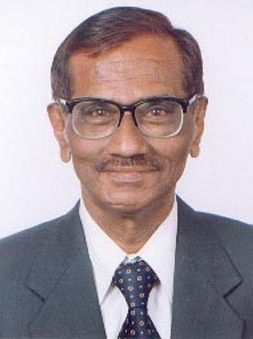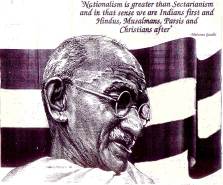
The Great Ahmedabad Trial Of Mahatma Gandhi 1922

I think it would be most appropriate to recall the great Ahmedabad trial at this juncture when the centennial of the Gandhian satyagraha in South Africa is being commemorated worldwide. When Mahatma Gandhi entered the Central Hall of the Government Circuit House at Ahmedabad on the 18th of March, 1922 to face a trial on a charge of sedition under section 124A of the Indian Penal Code about two hundred spectators inside the improvised courtroom stood up as a mark of respect to the frail figure in loincloth.
The spectators included Kasturaba, Sarojini Naidu, Pandit Malaviya, N.C. Kelkar, Smt. J.B. Petit and Ansuyaben Sarabhai. Sarojini Naidu has described how the entire court rose in an act of spontaneous homage to a “frail, serene, indomitable figure in a coarse and scanty loin cloth.” who joked in a characteristic manner looking at them saying: “This is like family gathering and not a law court.”
Gandhiji’s trial came in the wake of the mounting political tempo in the country following his call for non co-operation with the Government and boycott on the 1st of August 1920. The immediate cause, however, was the publication in Young India of three articles criticizing severely the repressive measure adopted by the government to put down the struggle. The articles in question were branded as seditious and calculated to cause disaffection against the existing government.
It was a “momentous and historic” trial. The issue raised by Gandhiji was not one arising ostensibly out of a breach on Section 124A, but the perennial one of “Law versus Conscience”. The trial was endowed with classic grandeur enveloped with a Socratic passion for truth emanating from Gandhiji’s lips.
There was not the slightest difficulty in establishing the guilt of disaffection, the accused having pleaded guilty with alacrity; but in doing so the illustrious accused performed the phenomenal trick of indicting his accusers the British Government.
How Gandhiji did it is one of the wonders of history and it demonstrates the triumph of soul force over brute force. Gandhiji termed Section 124A as the “Prince among the political sections of the Indian Penal Code designed to suppress the liberty of the citizen” and bluntly reminded the Government that “affection cannot be manufactured or regulated by law.
Gandhiji pointed out that he had no disaffection towards any particular person or administrator, but he emphasised: “I hold it to be a virtue to be disaffected towards a government which in its totality has done more harm to India than any previous system.”
More trenchantly still the Mahatma explained in his statement before the Court: “Non violence is the first article of my faith; it is also the last article of my faith; but I had to make my choice. I had either to submit to a system which I consider has done an irreparable harm to my country or incur the risk of the mad fury of my people bursting forth when they understood the truth from my lips.”
Gandhiji then made an extraordinary plea which he alone could have conceived and uttered sanctioned by his life long pursuit of the transcendent ideals of truth and non-violence. “The only course open,” Gandiji said; “to you, the Judge is either to resign your post which I know is impossible for you to do and dissociate yourself from evil if you feel that the law you are called upon to administer is an evil thing and that in reality I am innocent: or to inflict on me the severest penalty if you believe that the system and the Law you are assisting to administer are good for the people of this country, and that my activity us, therefore, injurious to the public weal.”
Such as impassioned utterance delivered in a Socratic manner must have had an ennobling effect on all those present in the Court Room. The trying Judge, Mr. R.S. Broomfield, rose to the occasion In passing the sentence he chivalrously conceded that “It would be impossible to ignore the fact that in the eyes of millions of your countrymen you are a great patriot and a great leader.”
Thus, the judge proceeded to pass a sentence, of six years, two years simple imprisonment on each of the three counts, taking as precedent of Lokmanya Tilak’s case. He classed Gandhiji with Tilak which Gandhiji considered as the “proudest privilege and honour.”
This grand and memorable trial of the Father of the Nation together with his printer, Shankerlal Banker, marks a watershed in the Indian struggle for freedom. It is a significant landmark because it brought to the fore and clearly defined the basic issues involved in any revolt against slavery, Every word uttered by Gandhiji in the course of this trial and the articles he wrote to defend his countrymen’s right of non violent non co-operation with an unjust imperialist system is aflame with patriotic passion and will ever remain a testament of freedom against tyranny.
Gandhiji staked his all to prove the superiority of spiritual as against man made laws because he held it to be “contrary to our manhood if we obey law contrary to our conscience.” The trial proved once for all Gandhiji’s indomitable faith in civil resistance. “To expect me,“ he said, ”to give up the preaching of civil disobedience is to ask me to give up preaching peace, which would be tantamount to asking me to commit suicide.”
The important issue in the present context when there is a national debate reduced to the filmy level of ‘Gandhigiri” on whether non violent direct action has any significant role to play in changing social relations in a society subject to the Rule of Law. Satyagraha can be a legitimate weapon to show dissent against an unjust law in a parliamentary democracy. For example thare is no reason why there cannot be A Gandhian satyagraha demonstration in the Gandhinagar itself against the unconstitutional Bill of the Freedom of Religion.
One is constrained to state that the Gandhian message being paraded on the celluloid screen as 'Gandhigiri" and debated on the TV channels is the ultimate travesty of the Gandhian message.
Perhaps the TV channels debates could have been better arranged in the suicidal environs of the Vidarbha region Who knows it might have served to reach the "Gandhigiri" message to the endless suicidal spree of desperate farmers. Where they can invite Sri Sri Ravi Shankar to give "counselling sessions" in the Art of Living as so thoughtfully suggested by the Maharashtra Chief Minister. It would be truly in the tradition of the queen Mary of France who in her royal majesty asked the starving masses to eat cake if they cannot get bread and spawned the revolution which started a global era of liberty, fraternity and equality.
Gandhiji was in fact more revolutionary in his social and economic outlook than the so-called fire-brand revolutionaries who are out to change the world at a stroke. In his passion for egalitarianism he would yield place to none. And that is why he could say in his Constructive Programme: Its Meaning and Place:
“Economic equality is the master-key to non-violent independence… A non-violent system of government is clearly an impossibility so long as the wide gulf between the rich and the hungry millions persists. The contrast between the palaces of New Delhi and the miserable hovels of the poor labouring class cannot last one day in a free India in which the poor will enjoy the same power as the richest in the land. A violent and bloody revolution is a certainty one day unless there is a voluntary abdication of riches and the power that riches give and sharing them for the common good.” (p.18)
It may be worthwhile also to recall what Gandhiji said: “Whenever you are in doubt, or when the self becomes too much with you, apply the following test: recall the face of the poorest and the weakest man whom you may have seen, and ask yourself if the step you contemplate is going to be of any use to him. Will he gain anything by it? Will it restore him control over his own life and destiny? In other words, will it lead to Swaraj for the hungry and spiritually starving millions. Then you will find your doubts and … self melting away.”